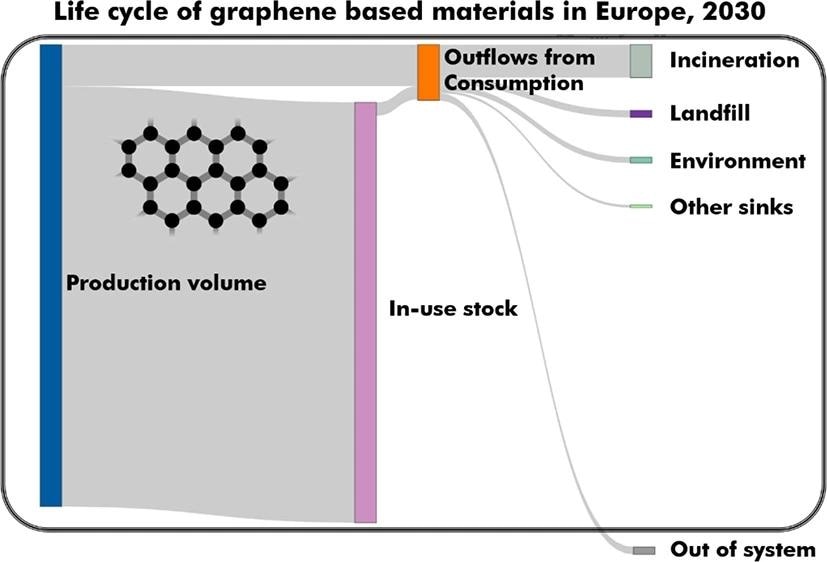Since their initial isolation, graphene sheets have been utilized across a broad range of industries. However, substantial research is required to investigate the possible environmental dangers of graphene-based materials (GBMs) as their industrial demand increases.

Study: Prospective Dynamic and Probabilistic Material Flow Analysis of Graphene-Based Materials in Europe from 2004 to 2030. Image Credit:Hong, H. et al. Environ. Sci. Technol. (2022)
A recent study published in Environmental Science & Technology addresses this issue by offering a preliminary evaluation of graphene's environmental concerns through dynamic probabilistic material flow analysis (DPMFA).
Graphene: The Material of the 21st Century
Graphene is a unique material made of a one-atom-thick honeycomb-patterned layer of carbon. Graphene is thought to be the world's thinnest, toughest, and most conductive substance. Many global research organizations are excited about graphene's characteristics because it can transform entire industries.
Graphene is the strongest substance on the planet and may be utilized to improve the strength of other materials. Many studies have shown that even a minute quantity of graphene added to polymers or metals may significantly increase their strength. These graphene-enhanced composite materials have potential applications in aerospace, construction materials, mobile electronics, and various other fields.
Graphene is employed in many commercial applications, including lightweight materials, conducting inks, anti-corrosion paints, and biomedical sensors, because of its high thermal conductance and electron affinity. Moreover, the high surface-area-to-volume ratio of graphene makes it a potential material for many energy storage applications like batteries and supercapacitors.
Environmental Concerns Associated With Graphene
The number of studies and publications involving graphene has expanded quickly due to its potential in various applications. This is projected to accelerate in the coming years due to rapid growth in graphene exploration, enhanced industrial manufacturing capability, and decreased manufacturing prices.
However, the rapidly expanding graphene usage has sparked widespread concerns about its possible environmental consequences. When new technologies emerge quickly, progress toward appropriate governance typically lags. The safe and sustainable design (SSbD) approach tries to remedy such gaps by introducing safety concerns in a preliminary phase of the product development framework.
In this regard, environmental risk evaluations of graphene based on the SSbD technique are crucial since many graphene products are still in the early phases of their development.
Life-Cycle Assessment of Graphene-Based Materials
Life cycle assessment (LCA) is a suitable method for determining the environmental risk of products and substances from the development and production phase through use and disposal.
It has been widely reported that as the volume of graphene production grows from the experimental and prototype studies to the industrial level, the cumulative environmental implications are projected to diminish. Graphene is not yet seen as a serious environmental risk by most life-cycle analytics.
Although life cycle assessment (LCA) is a valuable technique for analyzing ecological impacts, its application to synthetic nanomaterials such as graphene still has many limitations owing to a lack of life-cycle inventory statistics and nano-specific characterization parameters for toxicity-related consequences.
A Novel Approach for Environmental Risk Assessment of Graphene
Another approach for analyzing the ecological implications of substances is environmental risk analysis. Several ecotoxicity investigations on graphene have shown that it is hazardous to a variety of creatures, including bacteria, plants, and animals.
Material flow analysis (MFA) is a well-established approach for analyzing product flow and stocks across their life cycles. However, MFA lacks the crucial probabilistic features of a material's life cycle. Dynamic probabilistic material flow analysis (DPMFA) was created to address this issue and take into account the fluctuations in material production rates.
Given the scarcity of data on environmental fluxes and the vulnerability of graphene, the current study established a foundation for future environmental risk evaluations of graphene by predicting its distribution and determining projected release quantities in various environmental situations.
Highlights of the Study and Future Outlook
The current study was the first to simulate and quantify graphene release quantities into the ecosystem. Even though graphene production is predicted to rise rapidly in the future years, outflow from graphene utilization exhibited only a modestly positive trend owing to its long lifespan and the substantial in-use stock of graphene applications.
However, the analytical methods utilized to measure and differentiate synthetic nanomaterials from organic nanomaterials are inadequate. As a result, it is currently difficult to validate the release model of graphene used in this research.
Based on the above considerations, the findings of this research should be interpreted with care, although they may be useful for estimating realistic graphene concentrations in the future.
Reference
Hong, H. et al. (2022). Prospective Dynamic and Probabilistic Material Flow Analysis of Graphene-Based Materials in Europe from 2004 to 2030. Environmental Science & Technology. Available at: https://pubs.acs.org/doi/10.1021/acs.est.2c04002
Disclaimer: The views expressed here are those of the author expressed in their private capacity and do not necessarily represent the views of AZoM.com Limited T/A AZoNetwork the owner and operator of this website. This disclaimer forms part of the Terms and conditions of use of this website.